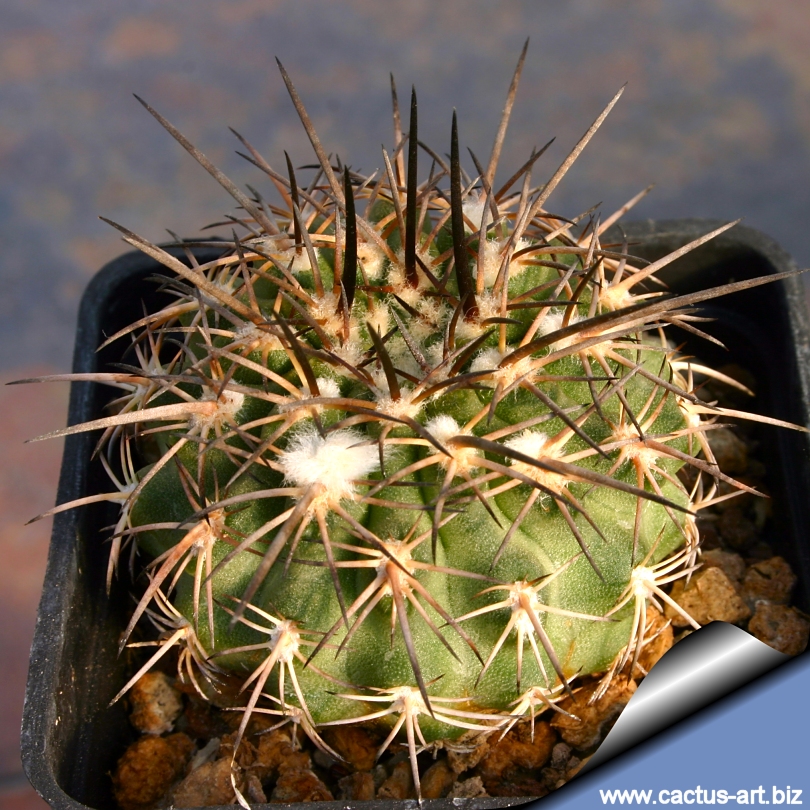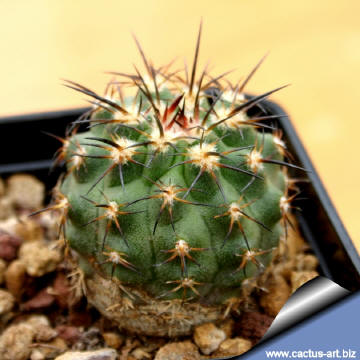|
|
|

Islaya copiapoides
This interesting plant has a large
stem and strong beautiful spines remembering a Copiapoa, hence the
species name.
|
 |
Description: E.
islayensis is a small
globose to
cylindrical cactus with very woolly areoles end dark spreading
spines, it is indeed very
variable and has received many names, but it is clear from fieldworks
that the different wild populations constitute a single but multiform
species. The var. copiapoides has fewer spines.
Stems: Grey-green, 5 to 40 cm
tall (or more long), 5 to 20 cm in diameter.
Ribs: 19 to 25 low and obtuse.
Areoles: Approximate, large, very
woolly, with grey-brown felt
Roots: Fibrous.
Spines: Variable in colour, horn-coloured, brow to shiny black,
turning grey as they age.
Central spines: 4 to 7 spreading, thick, 12-16 mm long.
Radial spines: 12 to 22, shorter, radiating, (1-)6-10 mm long. |
|
Flowers: Diurnal, 1,5 - 4 cm long and in diameter, born on
younger areoles from a yellowish
woolly crown in summer, wide
funnelform, yellow, outer perianth segments often reddish, floral tube
short with tufts of dense wool and long reddish bristles.
Fruit: Characteristic, up to 5 cm long, club shaped,
balloon-like, pinkish to red, openings at maturity by basal pores.
Pericarp initially fleshy but the interior always dry when mature.
Seeds: Broadly oval.
|
|
Advertising
|
|
|
|
Family:
Cactaceae (Cactus
Family)
Islaya copiapoides Rauh & Backeb.
Accepted
scientific Name:
Eriosyce islayensis (Foster)
Katt. 1994
Origin: E. islayensis
is endemic to the northern Chile along the coast, to southern Peru (just
south of Lima).
The var. copiapoides is found
along the coast in the middle of Islaya territory.
Habitat: Grows in very dry desert
areas where it almost never rains and where only the occasional sea fog
drift inland.
Etymology: The genus name "islayensis"
derives for the occurrence in the Province of Islay, Department Arequipa,
Peru. The variety name "copiapoides " comes from
the resemblance of this plant to
some copiapoas.
Conservation status: Listed in
CITES appendix 2.
Synonyms:
-
Echinocactus islayensis
C.F.Först. 1861
In: Hamb. Gartenz. 17:160. 1861
(Basyonym)
- Islaya islayensis (Först)
Backeberg 1934
-
Neoporteria islayensis (C.F.Först.)
Donald
& G.D.Rowley 1966
|
|
|
|
Cultivation:
It is a
summer grower species that, like many
cacti of the Peruvian deserts, present some problems in cultivation.
It is in fact somewhat
rot prone if kept in a non
ventilated place. Require a very fast draining drying soil,
water regularly in summer, but do not overwater.
Needs a
full sun exposure (or
light shade) Good heat tolerance.
Hardy to at least -5°C ( but probably can tolerate - 10° C for brief
periods)
Mature plants imported from the native habitats usually
did not take roots.
Propagation:
Usually propagated from Seeds.
(seldom produces offsets) or by grafting
onto a strong grafting stock like Selenicereus sp. Such grafted
seedlings can be been successfully cultivated for years.
|
|
Photo of conspecific taxa,
varieties, forms and cultivars of
plants belonging to the Eriosyce (Islaya)
islayensis
complex
(This
Taxon has lots of
synonyms whit several controversial varieties and subspecies and
comprises a multitude of different forms, but where each form is linked
to others by populations of plants with intermediate characteristics):


|
|